Whether you’re camping, picnicking, or spending an afternoon in the park, having a zip line for your dog keeps him safe and makes the time you spend together even more relaxing and fun!
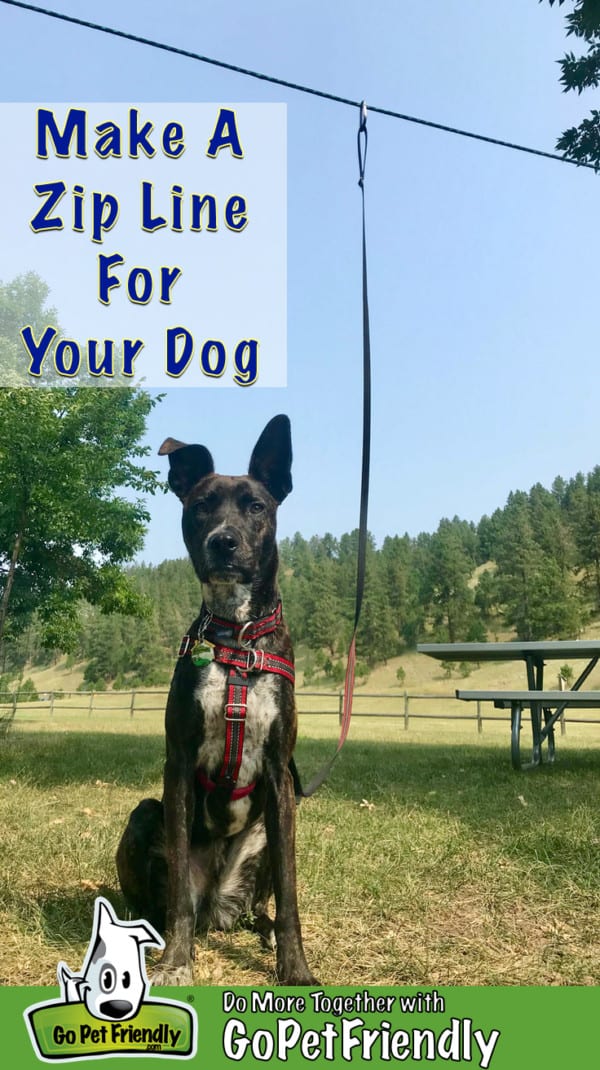
*This post contains affiliate links. Thank you!*
Keeping our dog safe, and abiding by the rules of many of the places we visit, means that Myles spend a lot of time on-leash. Though we’re always exploring new places, life at the end of a six foot tether doesn’t provide him with much freedom. So, to give Myles more room to wander while we’re camping, we made an inexpensive zip line for our dog!
Zip Line vs. Tie-Out
The zip line has a lot of advantages over cable tie-outs, which people often use to keep dogs from wandering off.
First, jumping up every two minutes to untangle your dog doesn’t happen with a zip line. If you have a dog who’s constantly wrapping his tie-out around the picnic table, tent stake, trees, and your chair, you know how impossible it is to relax with those shenanigans going on!
Second, you’ll never again feel the dread of watching your dog bolt to the end of their unforgiving cable tie-out. The zip line has more give and protects pets from injury.
Third, the zip-line won’t trip you when you’re stumbling around the campfire in the dark!
READ MORE ⇒ Tips for RVing with Pets
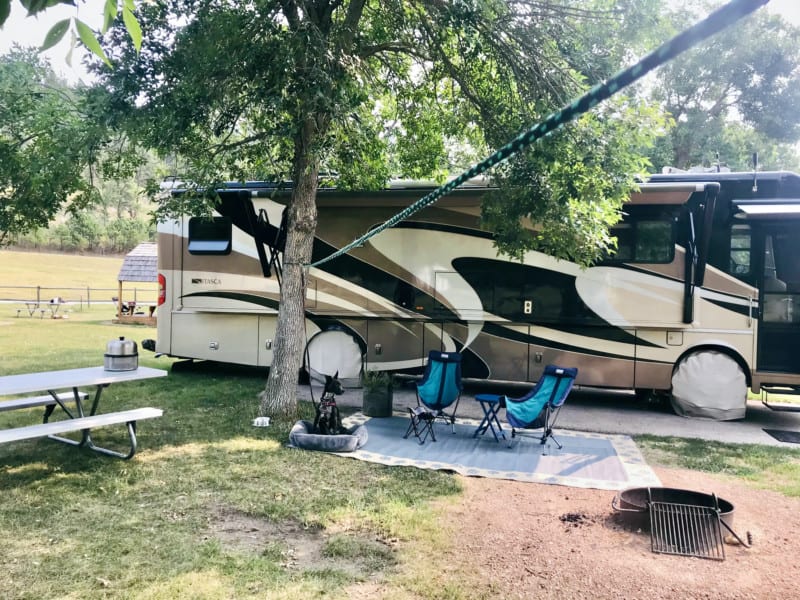
Materials and Assembly
All you’ll need to make a zip line for your dog is some nylon rope and two spring clasps. Any hardware store will have these materials, or you can order them online for about fifteen dollars.
We chose a rope with a smooth cover, which makes it comfortable to handle when we’re putting it up and taking it down. It also has a bit of stretch for some shock absorbency to protect Myles from a sudden stop.
Rod used his Eagle Scout skills to handle the knot tying. He made quick work of the two bowline knots, attaching the spring clasps to the ends of rope.
Melting the fibers by passing the raw ends of the rope though a flame keeps them from unraveling. And – SHAZAM – the zip line is ready for action!
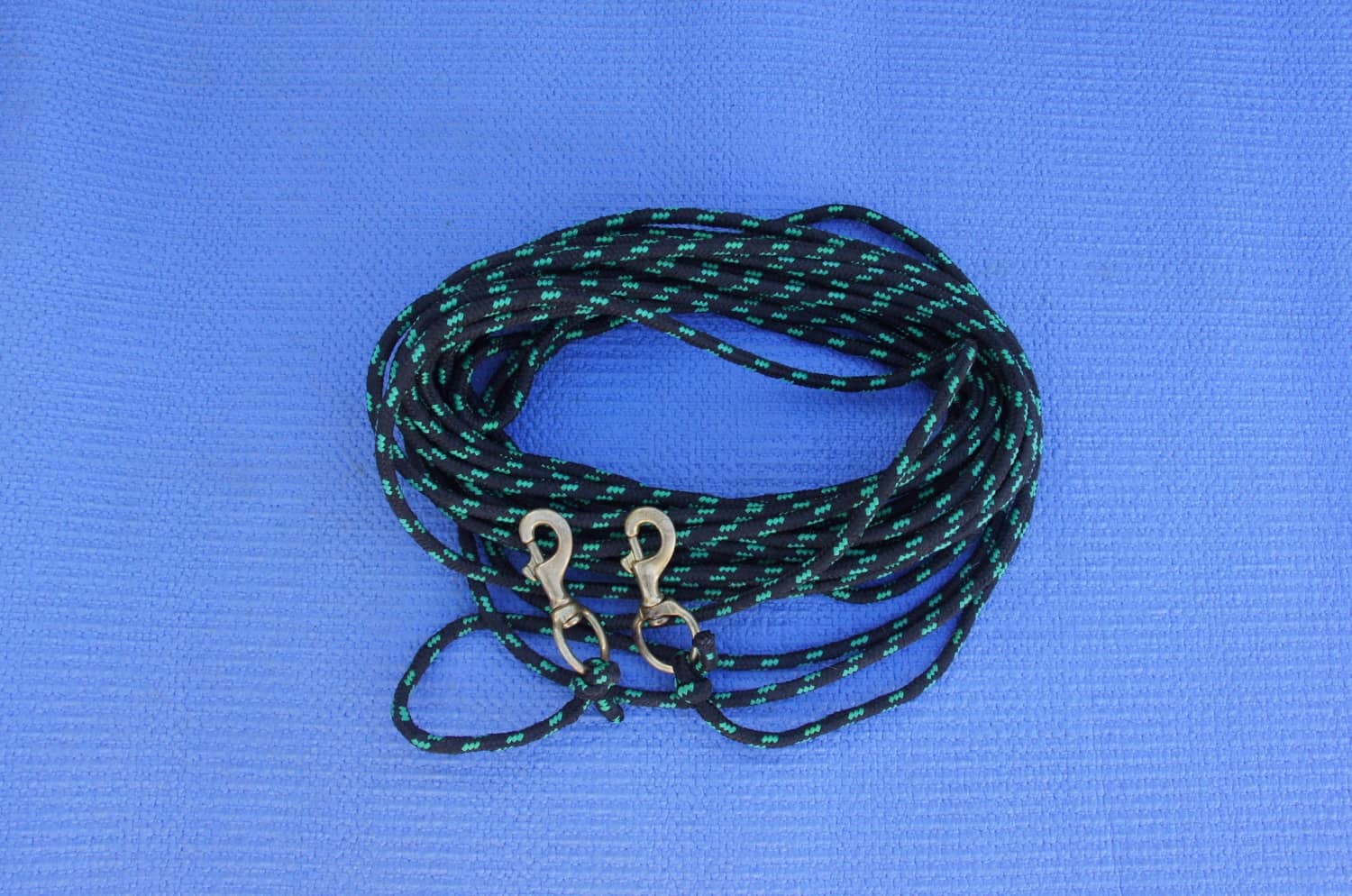
Deciding On Length
The most difficult part of making your zip line will be deciding how long it should be.
We decided on a 50 foot line, which gives Myles plenty of room to explore. And because having too much is better than not enough.
That length also gives us more flexibility if we’re at a campsite with few anchor points. If we don’t have trees, we can attach one end to the ladder on the back of our motorhome and the other to a picnic table or post.
Setting Up The Zip Line
Before setting up your dog’s zip line at a park or campground, check the rules to verify that they allow the rope to be wrapped around the trees. Also, placing a 1 to 2 inch webbing between the tree and the rope will help protect trees with soft bark. Nails and screws should not be attached to the tree when putting up your zip line.
It takes about five minutes to set up our zip line. In the photo below, we’ve wrapped one end of the rope around a tree and clipped the spring clasp on to the rope. Then, keeping the rope taught, we ran the rope to another tree, going around the tree as many times as necessary to take up the slack before clipping the spring clasp back to the rope.
The rope is placed high enough to just give Myles the ability to lie down comfortably. Giving him just enough leeway keeps him from building up too much velocity and jerking at the end of his leash if he decides to chase a gofer or give a squirrel a run for his money.
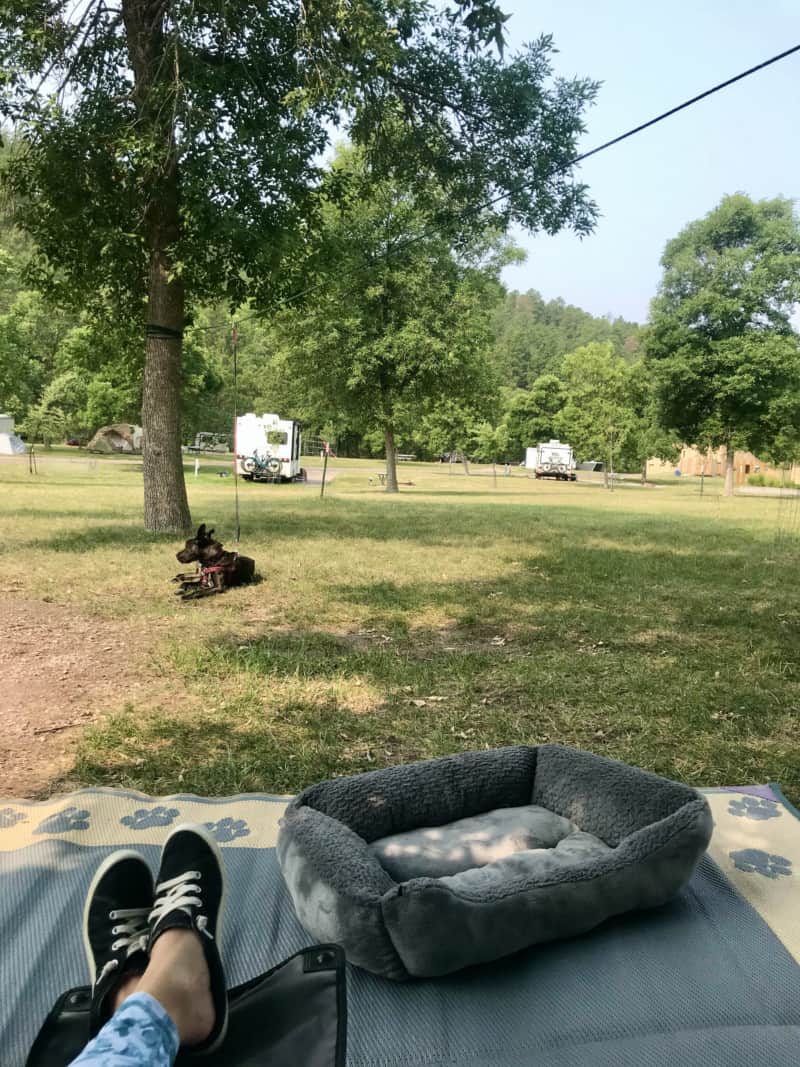
We also use the dog zip line when our campsites have a ramada. It’s easy to wrap the line around two posts and snap the ends back on the rope.
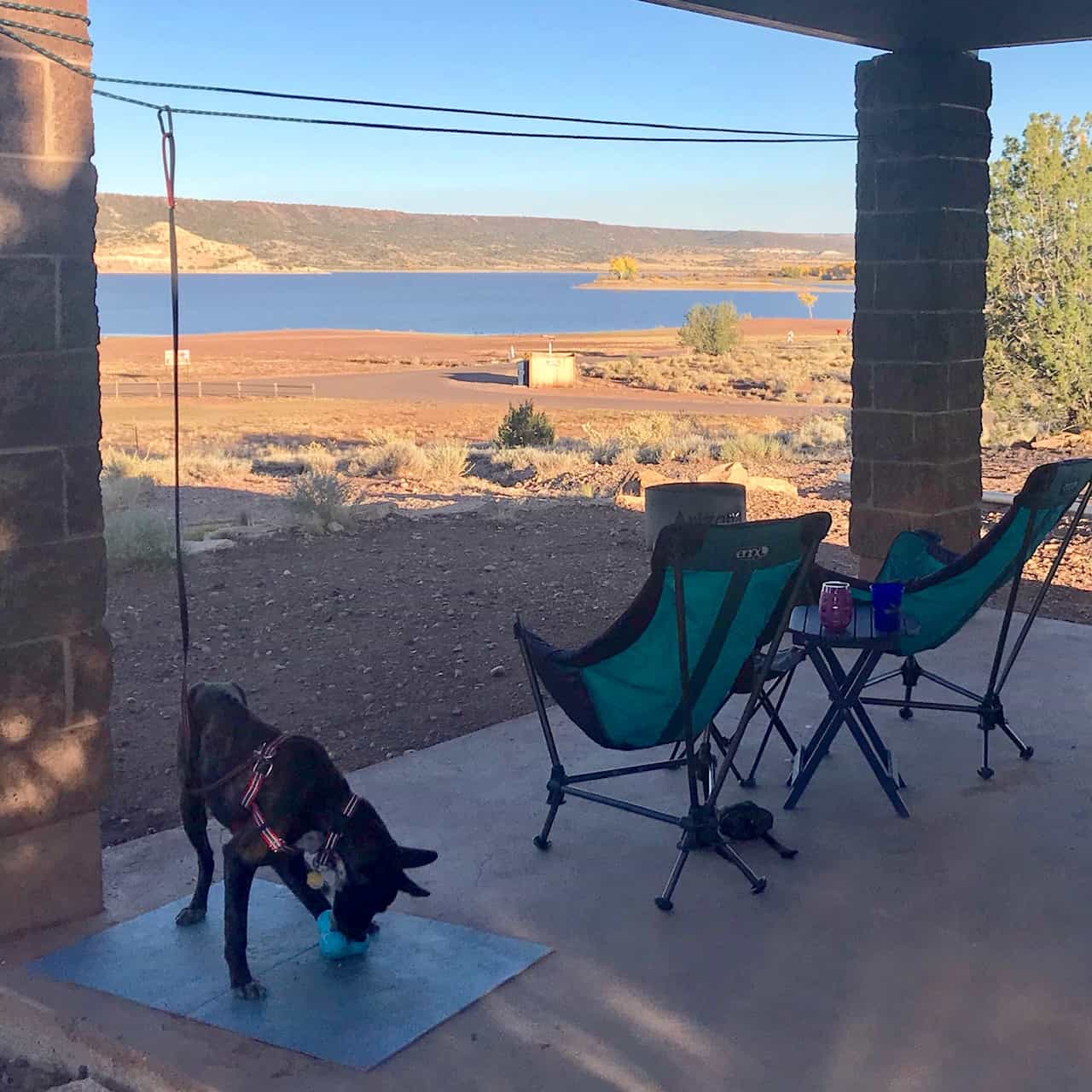
One Zip Line For Two Dogs
When we still had Ty and Buster, we made separate runs for each dog on the zip line.
We’d wrap the rope around the first tree and clip the spring clasp back to the rope. Then we’d make a complete pass around a second tree, creating the first section of zip line where Ty’s attached in the photo below. Then we’d wrap the rope around a third tree and clip the spring clasp back to the rope. That created the second run of zip line where Buster is attached in the photo below. Giving the boys their own space kept them from getting tangled around each other!
READ MORE ⇒ US State Parks That Welcome Pets
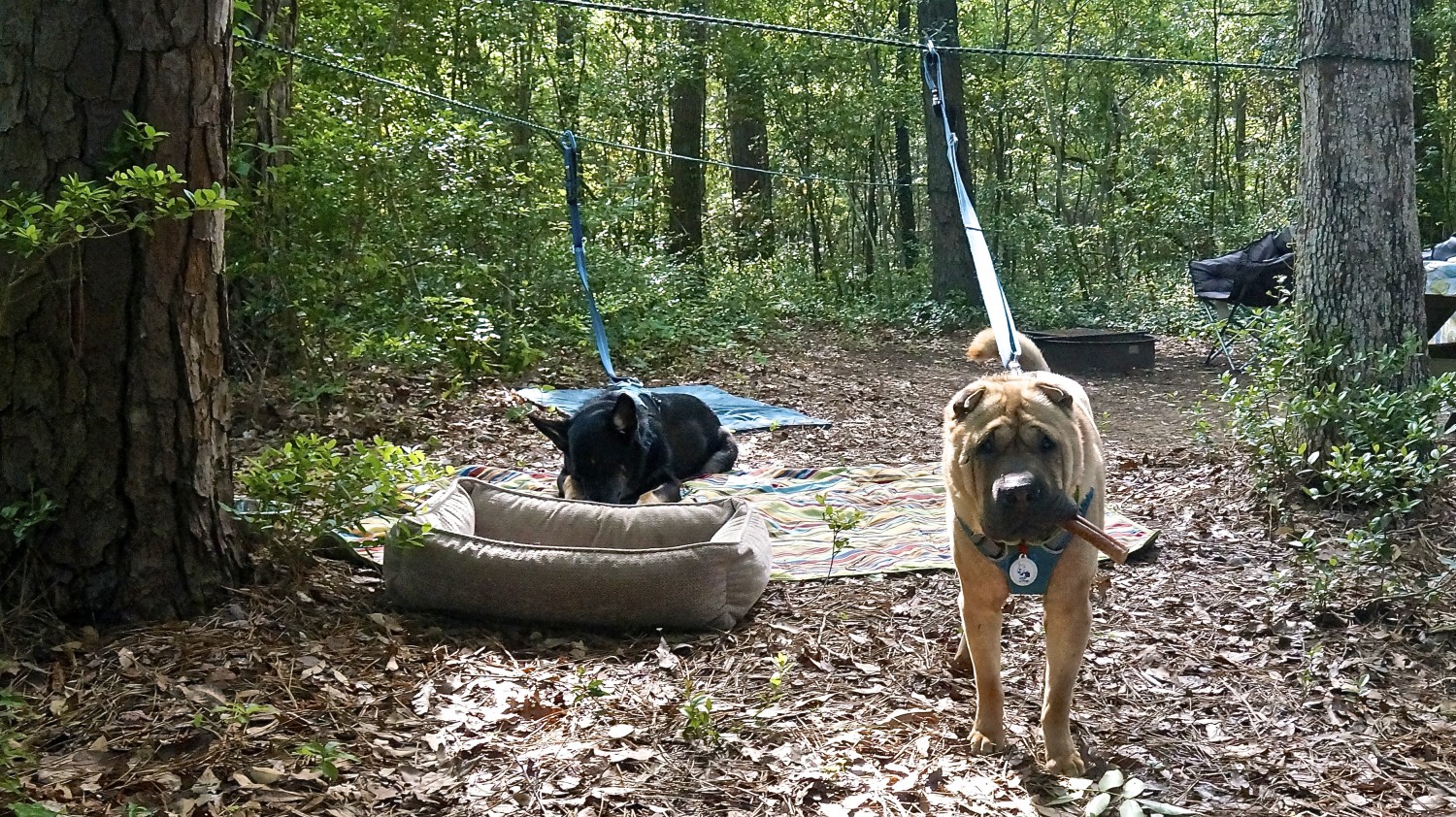
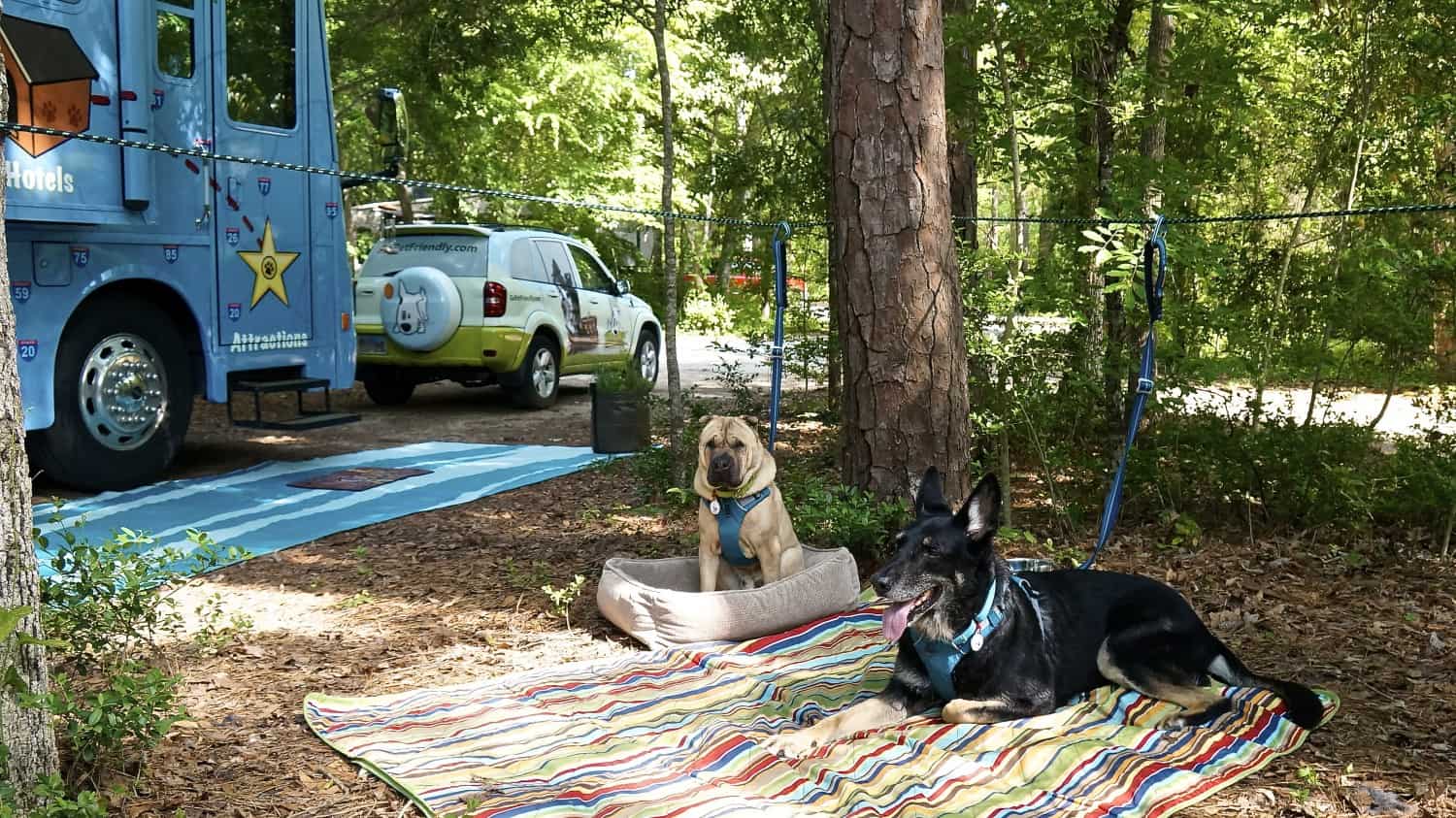
Connecting Dogs A Zip Line
Pets should never be attached to a zip line by their collar, because it could choke them if they became tangled. When he’s on the zip line, Myles wears his harness, which has a loop on the back to connect the leash. The final step is to slip a heavy-weight carabiner through the leash handle and snap it on the line.
What’s “heavy-duty” enough for your carabiners? It depends on your dog! Mass times velocity = force. So, if you have a 50-pound dog and he can accelerate to 5 mph on the zip line, a caribiner rated for 250 pounds should be sufficient. Again, it’s best to err on the side of safety.
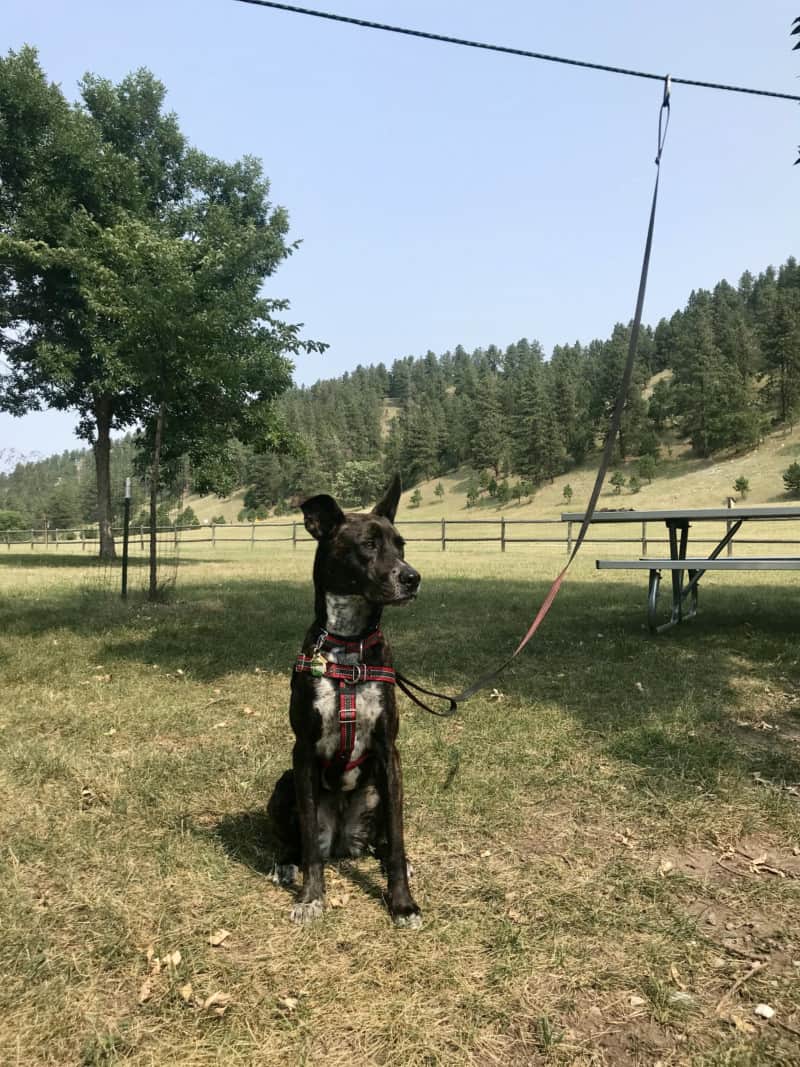
Place your pup’s water bowl within easy reach and you’re done! Just remember never to leave your pal unattended on the zip line.
Have you tried a zip line with your pets? Please share your experience in the comments below!
What You’ll Need For Your Dog Zip Line:
(Affiliate Links)2 Hounds No-Pull Harness or Ruffwear Front Range Harness
Heavy-duty Carabiner (1 for each dog)
Your dog’s leash
Amazon Affiliate Disclosure: GoPetFriendly.com LLC is a participant in the Amazon Services LLC Associates Program, an affiliate advertising program designed to provide a means for website owners to earn advertising fees by advertising and linking to amazon.com, audible.com, and any other website that may be affiliated with Amazon Service LLC Associates Program. As an Amazon Associate, the owner of this site earns a commission from qualifying purchases.
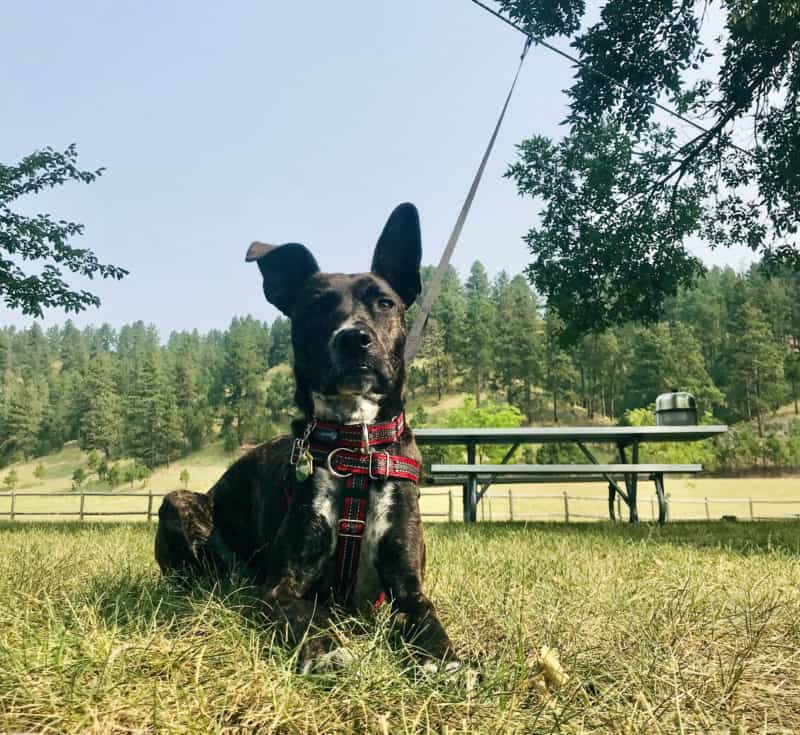
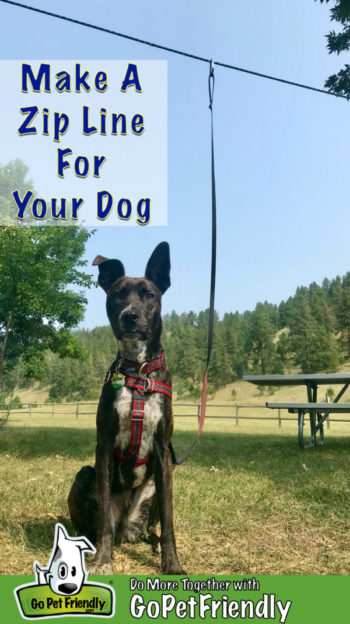
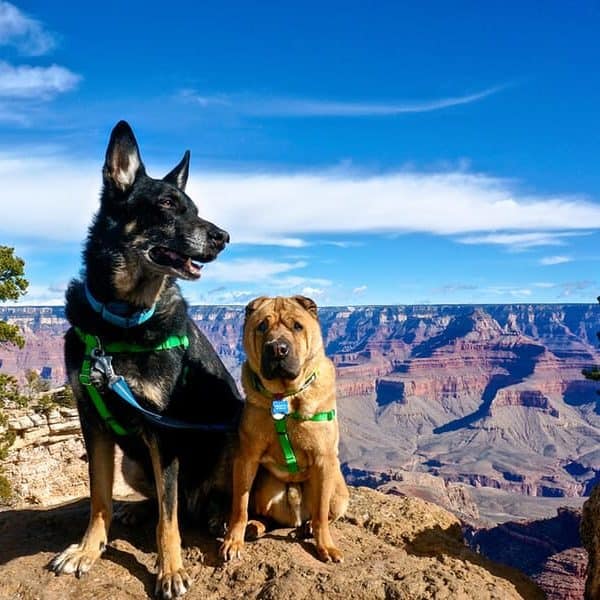
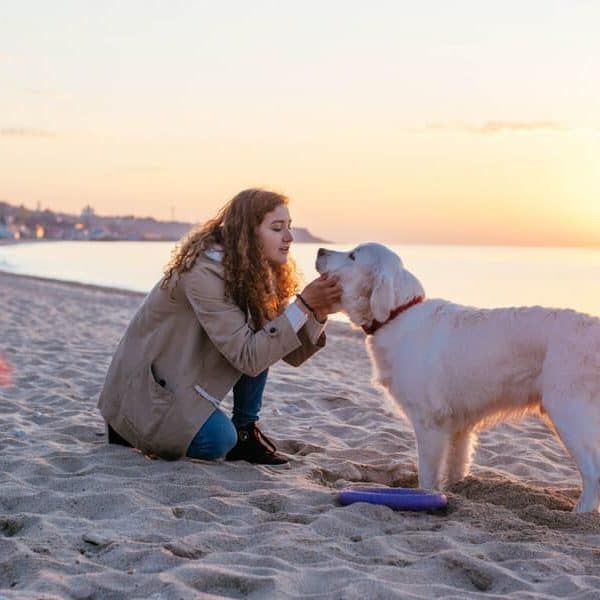
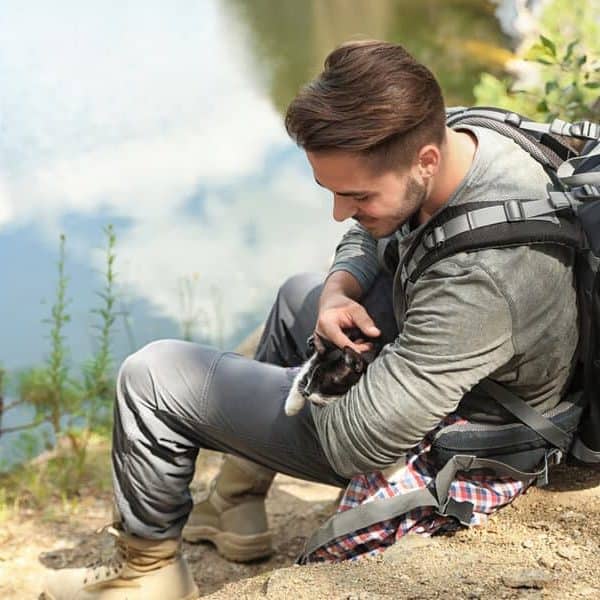
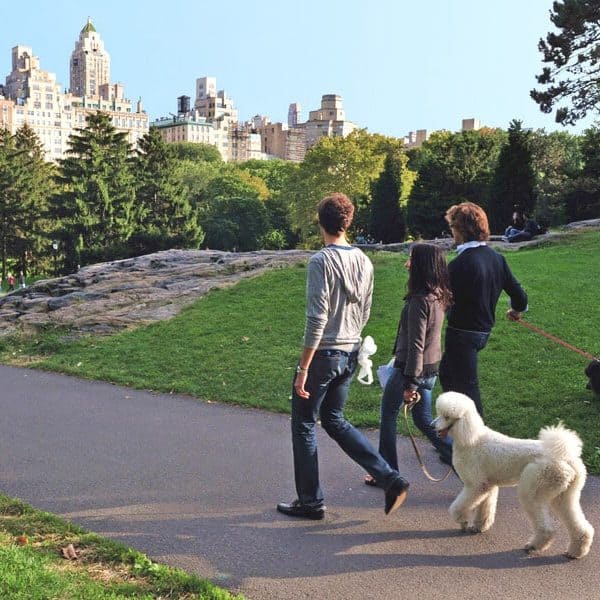
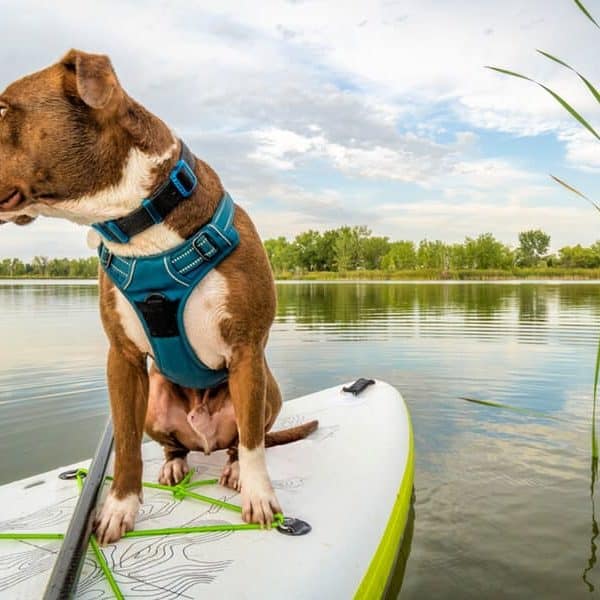
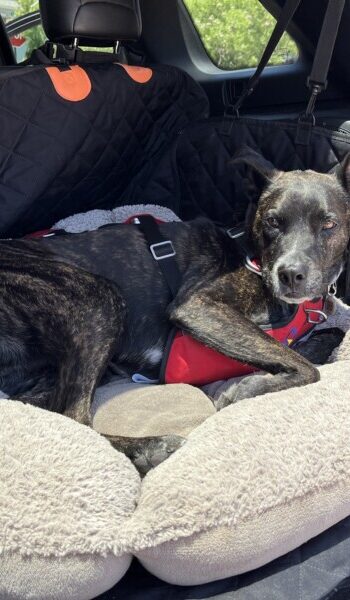
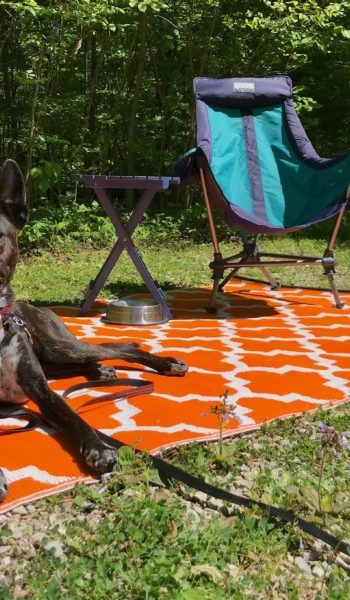



Thank you for this! We are first time full-time rv’ers and were going crazy with stakes! Can’t wait to try this!
This is a fantastic idea, we’re taking out two dogs camping with us and weren’t quite sure of how to do something like this…thanks so much!!!
We’re happy to help, Michele, and we hope you all have a fantastic trip!
We have a permanent RV spot and use something similar. We want the dogs to be able to go off the deck and into the trees on their own so we have 30′ (maybe 20′, can’t remember) leashes attached to the line. The problem is we’re constantly untangling the leashes or the dogs are taking out lawn chairs, tables etc if they see a squirrel or chipmunk and bolt off the deck.
I’ve thought about trying the retractable leashes but having a hard time finding a durable and large enough carabiner that I can get the handle through.
Great setup though!
Hi Gary! I agree, the zip line is great for giving a dog a bit more freedom without working they’ll go exploring on their own. I’d worry that the dog could get tangled in a retractable leash and get hurt. I got caught up in one once and had some pretty deep cuts. Thanks for your note, and have a great day!
Thanks for this! This could be life changing. Last summer was our first with a dog and the tie out was…not ideal. We’re going on our first trip of the season this weekend and I am excited to try this out.
YAY! I hope it works out well for you. We just moved into a rental house and one of the first things we did was set up a zip line on the deck for Myles. It’s definitely a life-changer!
My dog’s leash is 5′ long, is that long enough?
Sure! Just attach the zip line low enough that your dog has enough leash to lay down with no tension on his harness when the leash is attached to the zip line.
How high from the ground should your zip line be hung?
Hi Clarke! I hang it so that Myles just has enough room to lay down comfortably with no tension on the leash. Having it up higher keeps you from tripping over it, and also helps avoid abrupt stops if the dog chases a squirrel or chipmunk. Of course, you also don’t want it so high that your dog can’t lay down. I hope that helps!
Thanks, so you have their leash attached to it, I didn’t know that!
Yep, put the leash handle through a carabiner and then snap the carabiner on the zip line. Hope it works out for you!
Do you have any tips for RV campsites that have only one tree or hitch nearby?
Hi Beth! I’ve used a picnic table when we were short on trees, but you have to be careful not to trip over it! I’ve also attached one end to the ladder on our RV, which worked well. I hope that helps!
Thank you for the details! Though we don´t use this camping, it is working wonders in our larger backyard so our dog can run without worrying he will get outside a fence! I appreciate it!
That’s great, Carolyn! We’re happy to help. Thanks for your note!
Informative and practical article.
Clever idea to use a middle anchor point to create sections for each dog to avoid their leashes tangling.
Many Thanks!
My pleasure! Safe travels to you.
What do you do if the trees are less than 50’ apart?
Hi Taryn,
Thanks for your note! I just wrap the rope around the tree several times to take up the slack or make a knot in the rope to shorten the span. I hope that helps! Waggin’ trails to you.
How do the dogs get around the trees, doesn’t the pressure from the rope stop the clip from sliding
The dogs don’t go around the tree. The tree keeps each dog separated from each other, so their leashes don’t become entwined. If you only had 1 dog, you don’t need the tree.
Hi Laurie! Yes, the dogs just run on the zip line between the trees – they don’t go around them.
Hope that clears things up!
I have camped in Colorado, Oklahoma, California, Texas, New Mexico, Arizona, Washington, Arkansas, and have never had a ranger or camp host complain of ropes being tied from tree to tree; I see campers hang string lights, clotheslines etc… with rope. However we did see camphosts scold neighboring campers for screwing bolts into a tree (personally I think they should have been fined) nailing or screwing into a tree can leave it susceptible to getting disease. State park rangers and camp hosts, in my experience, seem to be very accomadating and are happy to share park rules. You can always call ahead and ask about dog rules. Many campgrounds don’t like pets to be left out ALONE, so you should always be able to have a place for them to stay safetly inside (out of heat) and make sure they will not BARK if you are leaving for an extended period or put them in doggy daycare (we used doggy daycare for long day trip train ride to Siverton, CO).
Thanks for sharing your experience, Elizabeth! We’ve had very much the same experience as you described. Safe travels and waggin’ trails!